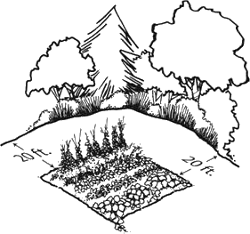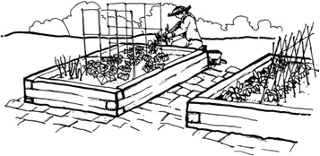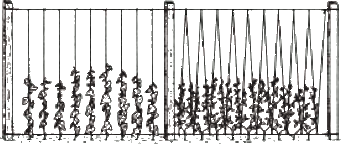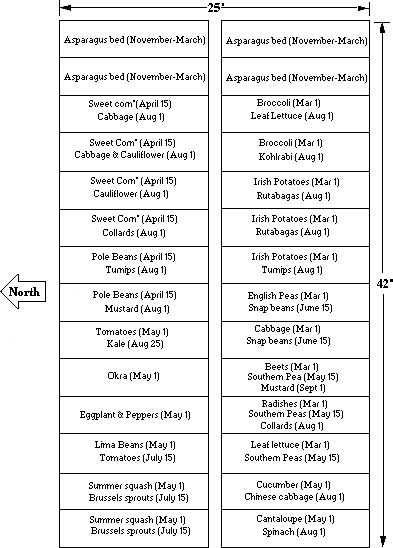17–22 minute read
Goals
Before focusing on the details, take a few minutes to consider your overall goals, needs and philosophy. A priority in one area often dictates adjustments in another. For instance, if a deer fence is critical, the size and layout of the garden may need to change.
Size
Over-ambitious spring-time gardeners curse themselves in the heat of the summer. Will the garden be used only for fresh eating or to grow enough to preserve or share? For fresh eating, a 4′ × 8′ plot is sufficient for spring and fall salad greens plus a few tomato, pepper, and cucumber plants in the summer. If a larger area is planned for the future, consider growing a cover crop there first to help build the soil.
Special needs
Gardeners with knee or back problems will appreciate an 18″ high raised bed. Similarly, children can have a dedicated garden adjusted to their size and abilities.
Organic garden
Vegetable species that are pest- and disease-resistant and have modest nutrient needs are always a good idea, but are particularly well-suited to an organic garden.
Protection
A deer fence or other barrier may be needed either around the whole garden or around individual beds. Groundhogs and/or rabbits will require additional measures of protection.
Beauty
An attractive garden will receive more attention. Or do you want to forgo a conventional garden and integrate a few vegetables and herbs into your landscaping? Edible landscaping (“foodscaping”) is a way to add vegetable and fruit plants to existing garden beds and containers instead of planting a separate food garden. Tucking edible plants among your flowers saves space, discourages weeds, adds interest to your yard, and provides pollinator habitats. In this video, we show you how to do it!
Siting
Sunlight
All vegetables need at least 6 hours of direct sun daily, but 8–10 hours is ideal. Site the garden away from the shade of buildings, trees, and shrubs. While some leafy vegetables such as broccoli, pole beans, and leafy greens like collards, spinach, and lettuce tolerate shadier conditions than other vegetables, they still require at least 6 hours of sun.
Convenience
The Chinese have an apt saying, “The best fertilizer is the gardener’s shadow.” A convenient location facilitates watering, weeding, and harvesting.
Air drainage
Air movement reduces disease problems and frost damage. Avoid locating the garden in a low spot where cold air cannot drain away, such as the base of a hill or the foot of a slope bordered by a solid fence. These areas are also slow to warm in the spring. Gardens located on high ground are more likely to escape light freezes, permitting an earlier start in the spring and a longer harvest in the fall.
 ID CES Planning a vegetable garden
ID CES Planning a vegetable garden
Tree roots
Site the garden at least 20 feet from trees, although some trees (especially maple, sweet gum, and mulberry) have roots that will still invade the garden to steal moisture and nutrients. Others, notably black walnut trees, secrete substances that inhibit the growth of other plants (allelopathy). In these cases, consider using either raised beds with a bottom barrier or containers.
garden styles
Decide what garden style best suits your site and your desired level of effort. Vegetable garden designs fall into three major categories: low-intensity gardens for large areas, high-intensity raised beds for small areas, and container or straw bale gardens for poor soil/limited space.
Low-intensity gardens
Row planting is the simplest style to implement and permits easy use of equipment, but wastes growing space and requires more weeding.
High-intensity raised beds
In raised beds, plants are placed at equal distances from each other on all sides, closely spaced so that leaves will touch at maturity. Vertical supports are common.
 ID CES Planning a vegetable garden
ID CES Planning a vegetable garden
Container gardens & straw bale gardens
Container and straw bale gardens are easy to install but require greater diligence to achieve good results. You must water and fertilize religiously.
 ID CES Planning a vegetable garden
ID CES Planning a vegetable garden
- How to Create a Container Garden for Edibles in the NC Piedmont
- Container Garden Planting Calendar for Edibles in the NC Piedmont
- Straw Bale Gardening
layout
Begin by drawing a diagram of the site layout showing the bed and path locations and dimensions (include an arrow showing north). Make extra copies for subsequent growing seasons or years.
Paths
Minimizing the number of paths reduces garden maintenance. Decide whether paths will be grass or another material, and make them wide enough for easy maneuvering of hoses and wheelbarrows. If paths will be grass, measure your lawn mower to ensure that it will fit.
Mulching materials for paths and beds
Orientation
Lay out the beds and/or rows to maximize the use of sunlight.
- If the ground is flat, rows should run north–south. Because shading is minimized, rows can be placed a little closer together than for other orientations.
- If the ground is sloped, erosion is a concern and so rows should run across the slope regardless of the direction. All plants in the row will be at approximately the same elevation.
- Keep tall plants from shading their neighbors by planting them on the north end of the garden. If your rows run north–south, the tall plants will not have rows of their own, but will rather be at the ends of each row.
Supports


 VA CES Intensive Gardening Methods
VA CES Intensive Gardening Methods
Use of vertical space with trellises, teepees, and fences will increase growing area and is easier on the back. Trellised vegetables also have fewer disease and pest problems. Temporary supports are more adaptable to crop rotations.
Perennials
Create a separate bed or garden area for perennial vegetables (eg. asparagus, rhubarb, French sorrel, perennial green onions).
details
Indicate on the diagram where, when, and at what spacing each vegetable will be planted. Including dates will help you remember tasks that might otherwise be put off until too late. A sample NC CES plan for a large traditional garden (25′ × 42′ = 1050 square feet for 3′ between rows) is shown below.
 NC CES Home Vegetable Gardening
NC CES Home Vegetable Gardening
Crops
Season
In Orange County, vegetables can be grown year-round using row covers to protect cool season crops. However, fall vegetable gardens can be tricky because they are planted in late summer or early fall (depending on the crop) when insect pressure is high, rainfall is erratic, and days are hot, leading to moisture loss from plants and soil. They are best attempted by experienced gardeners and may initially require chemical control. If you do not plant a fall garden, planting a cover crop will prevent erosion and compaction.
Nutrient needs
Fertility requirements vary by crop. Heavy feeders and light feeders can be grouped separately to help manage fertilization, although for intensive gardens, you may prefer to intermix them. The table below shows fertility needs (medium soil test for P & K) for some common crops:
| Need | N | P | K |
|---|---|---|---|
| lbs/100 sq ft | |||
| Light Medium Heavy | .08 .22 .30 | .09 .18 .28 | .09 .19 .28 |
Growing habit
Is the plant vining, tall or weed-intolerant? Tall crops should be placed so that they do not undesirably shade other crops (leafy vegetables like lettuce can tolerate some shade).
Local suitability
Chatham County has a list of vegetable varieties that are performing well for Doug Jones, the Land Lab manager for Central Carolina Community College’s Sustainable Farming Program in Pittsboro. He emphasizes non-hybrid varieties that have potential to be locally adapted and improved to approach the yield and quality of some of the better hybrids.
Crop rotation
Rotating vegetables so that the same vegetable or members of the same vegetable family are not planted repeatedly in the same areas is one of the most effective ways to prevent build-up of pests and diseases. Ideally allow 3–4 seasons between families, although this may not be possible in a single small garden. Consider two separated gardens if practical.

Succession planting
Succession means growing something new in the spot vacated by a spent plant. Here is an example using 3 families:
- Spring — mustard family
radish, kohlrabi, turnip greens - Summer — nightshade family
tomato, pepper, eggplant - Fall — goosefoot family
beet, spinach, chard
Long-season crops (those requiring more than 70 days before harvest) such as eggplant, tomato, pepper, and okra should be planted so that they don’t interfere with replanting short-season crops such as beans and lettuce. For vegetables like lettuce and radishes that are usually not preserved, try relaying: rather than planting many identical plants at once, either plant fewer repeatedly over the course of several weeks or plant two or more varieties that differ in maturity time (e.g., 50-day and 60-day beans).
Intercropping
Intercropping is the simultaneous culture of 2 or more vegetables (or a vegetable with a nonvegetable) in the same garden space in the same growing season. Intercropping makes the most efficient use of space and can reduce pest and disease establishment if vegetables from different families are used. However, mixing families does complicate rotation plans. Vegetables can be intercropped based on:
Season length
Long-season (slow-maturing, more than 70 days) plants like carrots and short-season (quick-maturing) plants like radishes can be planted at the same time. The radishes are harvested before they begin to crowd the carrots.
Size
Smaller plants can be placed close to larger plants, (radishes at the base of beans or broccoli).
Shade tolerance
Shade tolerant species like lettuce, spinach, and celery may be planted in the shadow of taller crops.
Nutrient requirements
Heavy feeders such as cabbage can be mixed with lighter feeders. Root crops, leafy crops and soil-building crops (legumes) may be mixed to take advantage of available nutrients.
Beneficial insects
Incorporate plants that attract pollinators and support beneficial insects.
- Plants that attract beneficial insects
- Beneficial insects in the garden
- Southeast plants for native bees
Soil
To maximize plant productivity, longevity, and health, you must address three distinct soil issues: structure, acidity, and fertility.
The fastest way to improve structure is to add organic matter. Heavy clay soils are usual here. Avoid areas that remain soggy after a rain, but otherwise focus on improving what you have rather than importing topsoil.
How to amend
Amend the soil with organic matter each season. Continual addition is important for two reasons:
- As the organic amendment breaks down, the structural benefits are lost
- As vegetables are harvested, nutrients are removed.
instructions
- Spade or till the soil to a depth of about 8″ (the full length of a shovel blade).
- Spread a layer of organic amendment about 2″ deep over the area and work it into the soil. Break up any clods of clay.
- Spread a second 2″ layer and add any necessary fertilizer or lime as indicated by the soil test report (this will not be needed every season).
- You can broadcast the lime and fertilizer over the top of the soil with a cyclone or drop spreader, half in an east-west and half in a north-south movement.
- Incorporate all to the full depth of the bed.
acidity & fertility
Soil test
A soil test will show the precise amounts of lime (to correct acidity) and fertilizer to add to your beds. Because soil can vary tremendously even in a small yard, be sure to take multiple samples in each growing area. You can pick up forms, instructions, and sample boxes at the Orange County Extension Center. NCDA soil test website
Lime
Because lime is poorly soluble, it works slowly and neutralizes acidity only in a small area around the particle. A fine grind #will work faster and neutralize the soil more evenly. Lime should be evenly mixed to the entire depth of the bed, preferably at least 6 months before planting. Never add more lime than is recommended — while the target pH will be reached faster, the pH will then overshoot and poison both plants and soil life.
Fertilizer
The timing and method of application depend on the type of fertilizer (synthetic vs. organic) as well as the target plant species, but some fertilizer is usually applied before or at planting time. A complete fertilizer with a formulation such as 8-8-8 (8 parts of nitrogen, phosphorus, and potassium) or 10-10-10 can be applied at the rate of 2 –3 pounds per 100 square feet when soil test recommendations are not available.
- Synthetic fertilizers usually act quickly and are more susceptible to leaching, so they are incorporated shallowly and applied more frequently, timed to coincide with plant growth, flowering or fruiting.
- Organic fertilizers must be broken down by soil microorganisms before they can be absorbed by plants, so they are often incorporated to the depth of the bed prior to planting.
mulch
Mulch helps to retain soil moisture and reduce weed growth. The choice of an organic or inorganic mulch depends on the season and what purpose the mulch serves.
- organic types decompose naturally in the soil
- inorganic types do not decompose and therefore must be removed after serving their pupose.
Organic mulch
Organic mulches are used by most home gardeners. They are the best choice if the goal is to conserve moisture and reduce soil temperatures during the summer. They can also help to reduce soil crusting. A variety of materials can be used, such as bark chips, compost, ground corncobs, chopped cornstalks, grass clippings, leaves, manure, newspapers, peanut shells, peat moss, pine needles, sawdust, straw, and wood shavings.
- Because organic mulches conserve soil moisture and reduce the soil temperature by 8–10°F, they should not be used too early in the spring. If mulches are applied to cold garden soils, the soils will warm up more slowly and plant maturity will be delayed. On the other hand, organic mulches can reduce soil crusting.
- After the soil warms in spring, an organic mulch may be applied to a depth of 2–4 inches around well established plants. Be sure that there is adequate moisture in the soil before applying the mulch.
- Mulches such as sawdust, wood shavings, and corncobs can use up some of the soil nitrogen as they decompose. To compensate, add 1–2 cups of 8-8-8 or 10-10-10 fertilizer to each bushel before applying them.
- Reduce weeds around the outside of the garden and between rows by putting down several layers of newspaper and then covering them with leaves.
Inorganic mulch
The greatest value of inorganic mulches is their ability to increase soil temperature very early in the growing season when the soil is cool. Because plastic film mulches serve as barriers to fruit rot and soilborne diseases, they are especially beneficial for crops that produce fruit on the ground, such as melons, cucumbers, squash, eggplant, okra, and tomatoes. They also reduce nutrient leaching from rainfall and keep mobile fertilizer nutrients from being lost from the root zone.
Plastic
Plastic mulches are easier to use if applied before planting. Soil moisture should be high before these filmlike materials are placed over the soil. Groundcloth is applied as strips, placing each over the prefertilized row to be planted, then burying the edges to prevent the wind from blowing it away. Short slits are then made with a pocket knife for depositing seeds or planting transplants.
